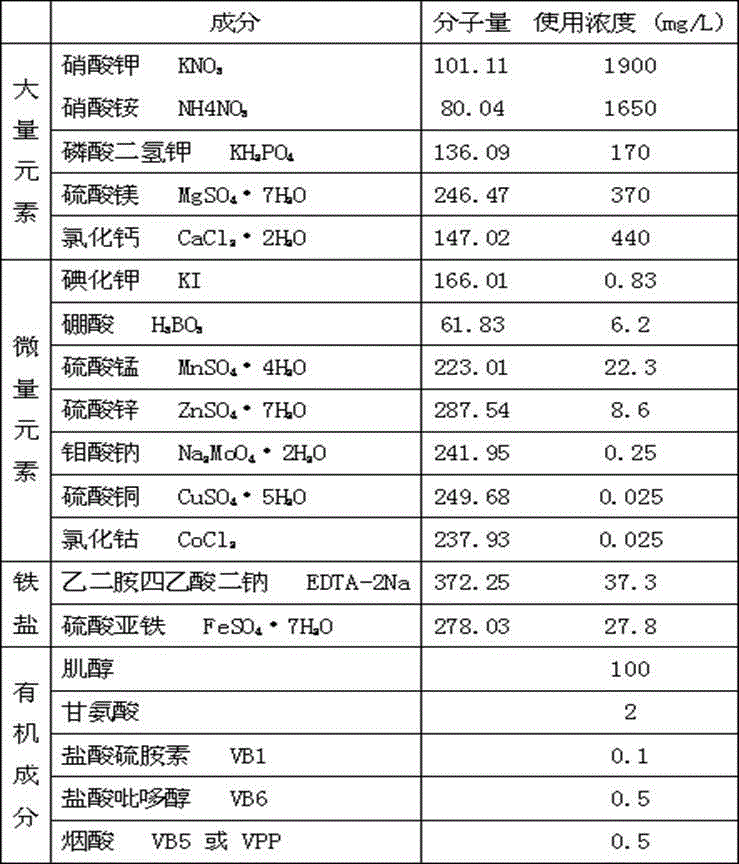Method for detoxifying lily based on embryogenic callus specific induction
A technology of embryogenic callus and embryogenic callus, applied in horticultural methods, botanical equipment and methods, horticulture, etc., can solve the problems of large demand for detoxification materials, poor resistance, and easy pollution of stem tip disinfection, etc. Achieve the effect of being suitable for promotion and use, avoiding the disinfection process, and having a good detoxification effect
- Summary
- Abstract
- Description
- Claims
- Application Information
AI Technical Summary
Problems solved by technology
Method used
Image
Examples
Embodiment 1
[0040] A lily detoxification method based on the specific induction of embryogenic callus, the detailed steps of the lily detoxification method are as follows:
[0041] 1) Specific induction of embryogenic callus from lily scales free of diseases and insect pests through tissue culture: select intact lily scales without disease spots, wash them with clean water, then soak them in neutral soapy water for 15 minutes, and then rinse them with running water 1 hour; soak in 75% alcohol for 40 seconds, put in 0.2% mercuric chloride for 10 minutes, rinse with sterile water 5 times, and then cut the scales into 0.5cm 2 Put the cubes into the medium for inducing embryogenic callus for dark culture, transfer once after 30 days, and form embryogenic callus after continuing to culture for 30 days, which is a medium for inducing embryogenic callus from lily scales It is: MS+2mg / L6-BA+1mg / L2, 4-D+6% sucrose+6.5g / L agar, the pH of the medium is 5.8;
[0042] 2) Induce embryogenic callus to ...
Embodiment 2
[0047] A lily detoxification method based on the specific induction of embryogenic callus, the detailed steps of the lily detoxification method are as follows:
[0048] 1) Specific induction of embryogenic callus from lily scales free of diseases and insect pests through tissue culture: select intact lily scales without lesions, wash them with clean water, then soak them in neutral soapy water for 20 minutes, and then rinse them with running water 2 hours; soak in 75% alcohol for 30s, put in 0.1% mercuric chloride for 15 minutes, rinse with sterile water 4 times, and then cut the scales into 1.0cm 2 Put the cubes into the medium for inducing embryogenic callus for dark culture, transfer once after 25 days, and continue to culture for 35 days to form embryogenic callus, which is a medium for inducing embryogenic callus from lily scales It is: MS+2mg / L6-BA+1mg / L2, 4-D+6% sucrose+6.5g / L agar, the pH of the medium is 5.8;
[0049] 2) Induce embryogenic callus to form seedlings an...
Embodiment 3
[0054] A lily detoxification method based on the specific induction of embryogenic callus, the detailed steps of the lily detoxification method are as follows:
[0055] 1) Specific induction of embryogenic callus from lily scales free of diseases and insect pests through tissue culture: select intact lily scales without disease spots, rinse them with clean water, then soak them in neutral soapy water for 18 minutes, and then rinse them with running water 0.5 hours; Soak in 75% alcohol for 35s, put in 0.15% mercuric chloride for 13 minutes, rinse with sterile water 6 times, and cut the scales into 0.8cm 2 Put the cubes into the medium for inducing embryogenic callus for dark culture, transfer once after 35 days, and continue to culture for 25 days to form embryogenic callus, which is a medium for inducing embryogenic callus from lily scales It is: MS+2mg / L6-BA+1mg / L2, 4-D+6% sucrose+6.5g / L agar, the pH of the medium is 5.8;
[0056] 2) Induce embryogenic callus to form seedlin...
PUM
 Login to View More
Login to View More Abstract
Description
Claims
Application Information
 Login to View More
Login to View More - R&D
- Intellectual Property
- Life Sciences
- Materials
- Tech Scout
- Unparalleled Data Quality
- Higher Quality Content
- 60% Fewer Hallucinations
Browse by: Latest US Patents, China's latest patents, Technical Efficacy Thesaurus, Application Domain, Technology Topic, Popular Technical Reports.
© 2025 PatSnap. All rights reserved.Legal|Privacy policy|Modern Slavery Act Transparency Statement|Sitemap|About US| Contact US: help@patsnap.com

